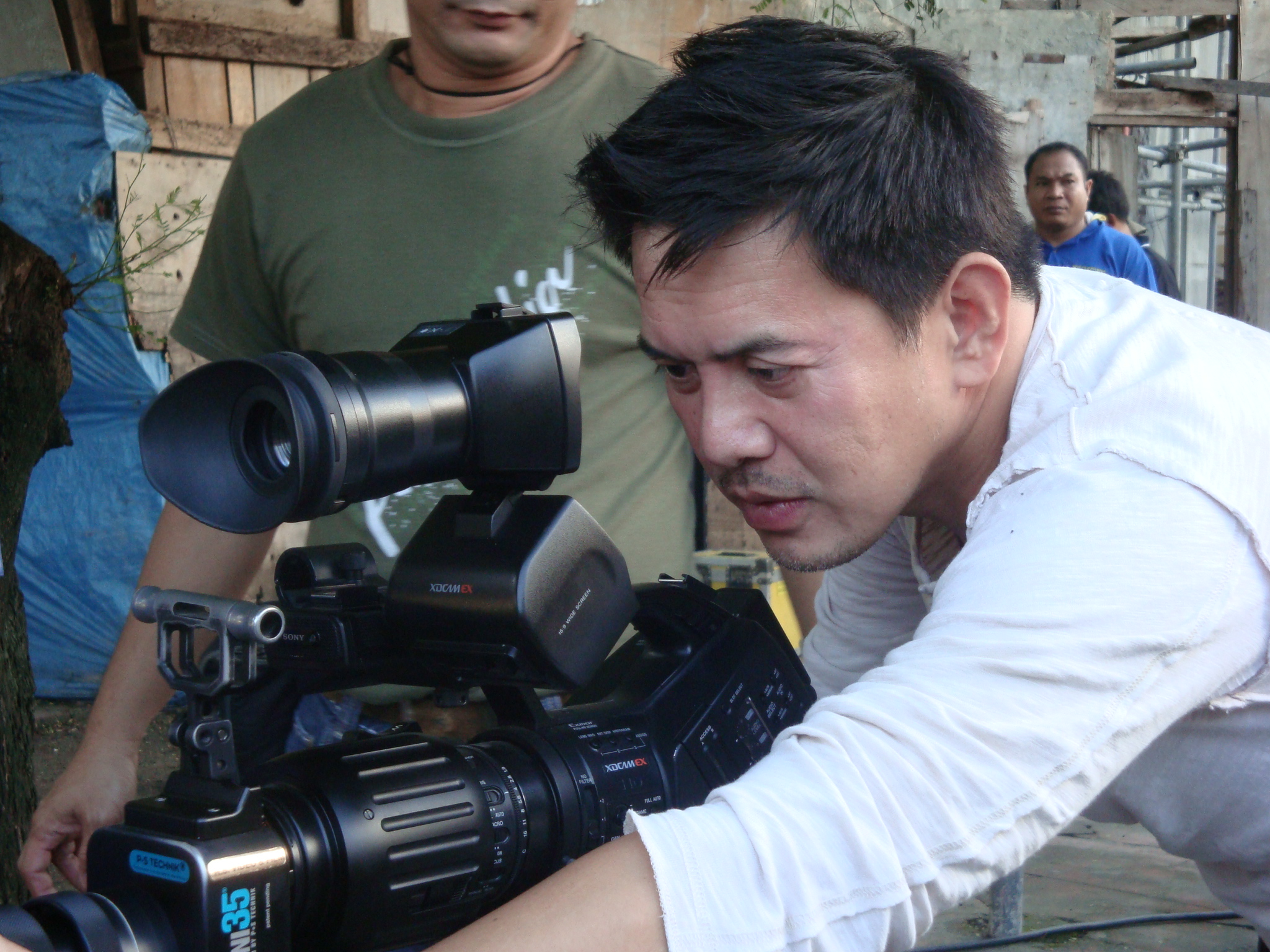An Interview with Brillante Mendoza, Part 1


The year 2005 was a pivotal moment for Philippine independent cinema. Indie films, long relegated to the margins of Philippine cinema, finally gained mainstream acceptance via the opening of the Cinemalaya Independent Film Festival. The aim of the festival is to fund the works of new and promising filmmakers who can present a unique and innovative mode of storytelling without the repressive control of mainstream movie studios, albeit with less than half of the usual mainstream budget. In the same year, seemingly out of nowhere, Brillante Mendoza burst into the indie scene with Masahista (“The Masseur”). Like other indie films, The Masseur did the usual tour of international film festivals but with relatively more success, winning the Golden Leopard for Video at the Locarno International Film Festival, the Audience Award at the Torino International Gay & Lesbian Film Festival, and the Interfaith Award at the Brisbane International Film Festival. In a country where most indie directors are in their twenties and early thirties, it was an impressive debut for the then-45-year-old novice.
As a director Mendoza might be considered a late bloomer, but he is not exactly new to film production. He started his film career in the mid-1980s as a production designer, working for controversial directors such as Chito S. Roño and Tata Esteban. By the 1990s, Mendoza left the movie industry and started what would turn out to be a very successful career in television advertising, paving the way for him to put up his own production company. Founded in 2005, Centerstage Productions signalled Mendoza’s return to filmmaking, with The Masseur as its first production. Mendoza would then demonstrate his prolificacy by directing eight more feature films within the next five years. More importantly, he would indeed live up to his name (Brillante means “brilliant” in English) by being nominated for the Palme d’Or at the 2008 Cannes Film Festival for his movie Serbis (“Service”) and eventually winning the Best Director award at Cannes the following year for his unapologetically brutal Kinatay (“The Execution of P”). With that victory, Mendoza was able to once again secure a place for Philippine cinema in the world stage.
As a whole, Mendoza’s cinema ― with its vision of poverty, sex, and urban alienation ― owes a lot to the late Lino Brocka. Indeed, ever since Brocka made Maynila: Sa Mga Kuko ng Liwanag (“The Nail of Brightness,” 1975) and his Jaguar (1979) became the first Filipino film to compete in Cannes, these themes have become a common fixture in Filipino films. At the same time, traces of 1940s Italian Neorealism (of which Mendoza is a big fan) are also evident in Mendoza’s works, particularly in Manoro (2006), The Execution of P and most especially in Tirador (“Slingshot,” 2007). Thus, his films can be seen as a 21st century appropriation of Italian neorealist aesthetics and the socio-political themes previously explored by Brocka. But unlike Vittorio de Sica and Brocka who use characters as metaphysical symbols and view poverty as a consequence of war or a corrupt government, Mendoza sees poverty as an everyday reality. His characters are what they are not because of war or because their government has neglected them; it is simply a fact of Filipino life. Indeed, Filipinos have been surrounded by poverty for so long that they have grown accustomed to it.
As of this writing, Mendoza has just finished his ninth feature film, tentatively titled Bitag (“Trapped”). Inspired by real events, the story is about the kidnap of foreign tourists by the notorious bandit group Abu Sayyaf in the southern part of the Philippines. The film explores themes which are seldom touched by Mendoza’s contemporaries, and yet this is an issue that continues to torment the country. The idea for the film has been playing in Mendoza’s mind years before the cameras started rolling. But what truly sets the film apart is that it stars Cannes Best Actress winner Isabelle Huppert (Violette Nozière, 1978; The Piano Teacher, 2001), the first time an award-winning international actress will star in a Filipino independent film.
I first interviewed Mendoza in 2010 while I was doing research for my graduate thesis on Filipino independent films. I have interviewed him several times since then. The following are excerpts from my conversations with the award-winning filmmaker:
Elvin Valerio (EV): I’m here to discuss your aesthetics as a filmmaker. Specifically, I want to focus on four of your films, namely: Slingshot, Service, The Execution of P, and Lola (“Grandmother,” 2009). But first, let’s talk about the medium that you use. The weapon of choice, so to speak, of Filipino indie directors today is digital video. You, however, would sometimes switch to the more expensive 35mm. Is video really your preferred medium or is it because video is a much cheaper alternative to film?
Brillante Mendoza (BM): I really prefer video over film. Yes, video is more financially accessible and the new hi-definition video cameras that are coming out can present images that actually look like film. But for me, video is also very liberating to use in terms of mobility. It really fits my style as a filmmaker. I can’t imagine shooting Slingshot on film because I was running after the actors most of the time. But there are other films, like Service specifically, that I want to shoot in 35mm because it is a tribute to cinema.
EV: Let’s now discuss Slingshot, your fifth film. I actually look at Slingshot as the first Brillante Mendoza film in the sense that it firmly established the style that you will use and the milieu that you will constantly explore in your succeeding films.
BM: I’ve always been attracted to that kind of environment and Slingshot served as a reason to finally delve into that world. At that point in my career it was something new for me.
EV: The English translation of the title, while accurate, doesn’t really give justice to the film because “tirador” is also street slang for “backbiter” or “traitor.” I guess that’s what you actually meant.
BM: Yes, because the film deals with con artists and petty thieves. “Tirador” is what they’re called in the slums.
EV: One of the scenes that really blew me away was when Julio Diaz and Coco Martin had this argument about the bicycle which quickly turned into this big fist fight that looked so real; and the hand held camera added a sense of immediacy to it. It’s like you achieved this whole new level of realism. How did you stage that scene?
BM: First of all, I have this thing about fight scenes in movies. Somehow, most of them never seemed real to me. You can already tell that it was choreographed. I have seen people fight in real life and it’s never the way they do in movies. So I have to find a way to do it as realistically as possible without hurting the actors. Before we shot the scene, I told everyone that whatever happens they should not stop and that they remain in character until I say “Cut.” Then I approached each of the actors one by one and gave them instructions which the other actors do not know about. For example, I told Julio Diaz that he should do everything he can to try and hit Coco. Then I said the same thing to Coco. With the young boy who played Julio’s son, I told him that no matter what, he should try to stop Coco from hitting his father. With Jacklyn Jose, I told her that she should do everything she can to stop Julio and Coco from hitting each other. So for that scene, each actor has a different objective which the others do not know about.
EV: At one point, it even appeared that Julio unintentionally hit the camera.
BM: Yes, and I kept that shot because it added a sense of realism to the scene. That fight scene is my favorite because I felt that it came out exactly as I envisioned it.
EV: Another scene that I find amusing is when Angela Ruiz’s character, Tess, drops her dentures in the sink and it went all the way down into a small dirty canal at the side of the street. I like the way she reacted, that sense of frustration. How did you find her?
BM: I just thought that this was something you don’t normally see on film – a young actress losing her dentures, and a real one at that. Angela was among those who auditioned for the part. I was looking for someone who’s pretty but has dentures and is willing to remove them on film. I never seriously thought that I would actually find such an actress but there she was.
When we shot that scene, I reminded her of what her character has gone through in order to pay for those dentures. She had to lie and steal and risk her life. So when her brand new dentures literally “went down the drain,” I told her that we should see that sense of loss. Her neighbours might not take her seriously but for her, it’s the one thing that makes her complete, that makes her feel beautiful. Angela understood that and gave a very convincing performance.
EV: I think we can see your excellent use of “non-actors” with Benjie Filomeno. He played the father of Jiro Manio’s character, Odie, and he was simply fantastic. Considering that Jiro is a brilliant young actor, he really fared well in their scenes together, especially in the opening scene when the cops came to their house and they had to pretend he’s sick.
BM: Benjie was an artist whom I met way back in the 80s. He used to hand-paint those huge movie billboards that were so common back then. I hired him as one of my artists when I started doing production design for TV commercials. I already cast another actor for that part of Jiro’s father but unfortunately he got sick so I asked Benjie if he’s interested. He declined because he obviously knows he’s not an actor. But I assured him that I will not ask him to act the way it’s done in mainstream movies. I just told him, “Do what you feel is right.” So I did not really teach him how to act. Acting is not something I can teach because I believe it’s purely instinctive. For me, acting is all about feeling and not about performing. I treat all my actors the same way, regardless of whether they are professional or not. I’m not the kind of director who’s into giving grand instructions to my actors. Like I said, everything is instinctive. I don’t even block my actors. What I do is just explain to them what the scene is about and see how they would translate it in terms of blocking and movement. I even allow them to improvise with the dialogue, although there are specific lines that they should not forget.
EV: So, you’re not strict when it comes to dialogue?
BM: Not really. Because I believe that dialogue should be flexible. The essence of a scene, for me, is not always dependent on dialogue. Film is a visual medium so sometimes it is more important to focus on what we see rather than what we hear. The really good actors do not need words to communicate the essence of a scene; the expressions on their face and their body language are more than enough to convey that.
EV: I also like the idea that the place is surrounded with campaign posters of different politicians promising to deliver economic progress to their constituents and yet, what we see in the film is exactly the opposite.
BM: We shot the film during election season so those posters were real. I decided not to remove them so we can get that sense of irony. The people in the slums no longer believe that voting for these politicians will actually make their lives better. Election in the Philippines has become one big farce. That’s why we have that scene where they all line up to receive money from some politician in exchange for their vote.
EV: And of course, the film ends with this huge political rally.
BM: Yes. Again, what we hear are just empty rhetoric. They talk a lot but they don’t make sense so nobody listens anymore. People are just waiting for whoever movie star is appearing onstage.
EV: Let’s now move on to Service. One of the aspects of the film that really struck me was the production design, especially your use of the movie posters and hand-painted billboards. They seem to be commenting on what’s happening in the scene. How did you come up with this approach?
BM: Since my background is in art direction, I look at design as an integral part of the film. It helps in telling the story, in revealing something about the characters and the world they live in. An interesting thing happened while we were scouting locations. When we saw that old movie theater in Pampanga, it was really this dirty decrepit structure with a lot of graffiti on the walls. We all agreed that this place is perfect as it is. Even the name of the theater, Family Theater, is perfect for the film, right? Unfortunately, when we came back a few months later to shoot, the owner thought it would be a good idea to have the whole building repainted. It was so clean! We had no choice but to repaint it and make it look old and dirty. Then I realized this is actually good because I can choose the color I want and the kind of graffiti that would reflect the story. So it gave me more room to create this world for the characters. I want to audience to be able to almost touch the dirt and feel the heat and really look at the posters and graffiti. Hence, the movie theater becomes another character.
EV: These old art deco types of movie theaters are actually more common around Manila and even the kind of story that you’re telling is something we can easily imagine happening in Manila, but you shot your film in Pampanga. Was it your intention to shoot it in the province or finding the right movie theater is more important?
BM: First of all, Service was supposed to be my second film, which means the script has been around for quite some time. In the early versions of the script, the story actually takes place in Quiapo because, like you said, there are a lot of old movie theatres around Manila. But when I was looking for locations and doing my research around the city, somehow I couldn’t find the right one. That’s when I realized that the theater is more important, so I began looking for old theatres outside of Manila. We went to different provinces like Batangas and Laguna until we finally saw the Family Theater in Pampanga.
EV: So I guess the Kapampangan dialect was added later on? All your actors sounded so convincing, especially Jacklyn Jose and Gina Pareño.
BM: Yes, it was only added after we decided to shoot in Pampanga. They all had to practice and learn how to properly pronounce the words. With Jacklyn it was easy because she’s really from Pampanga, although she’s lived in Manila for a long time. She still knows the dialect but she had to relearn the accent. Gina’s character is more difficult because her character is from Ilocos and they speak a different dialect there, so Gina had to learn two dialects. In the script, her character would mix Ilocano, Kapampangan and Tagalog when she talks.
EV: Service is your first film co-produced by Didier Costet. How did the two of you meet?
BM: Didier is this French film distributor whom I met when Slingshot competed at the Morocco Film Festival. When I won the Jury Prize, he came up to me and offered to buy the international rights of Slingshot and The Masseur. So we talked, had dinner, and that’s when I told him about my next project, Service. He became interested so I asked him if he wanted to invest and he did. When I submitted Service to Cannes, I did not tell him about it. It was only after the film was accepted in competition that I told him. He was pleasantly surprised because he had no idea at all. He co-produced all my films after that.
EV: Service is also a departure visually from the cinéma vérité style of Slingshot. The milieu is basically the same and there is still a lot of camera movement, but it’s more restrained; the pace is slower. You have a lot of these long takes where the camera just follows the actors as they go up and down the theater and there’s hardly any dialogue. Was this something that’s already indicated in the script?
BM: Not really. It’s something I thought about when I was planning the shots. It’s how I interpreted Armando Lao’s script. A good example is the opening scene where Roxanne Jordan’s character, Jewel, is getting dressed and she stands naked in front of the mirror and stares at herself. Some critics said that it was unnecessary and a bit exploitative. But the thing is Armando never wrote it that way. He simply wrote that Jewel is getting dressed. The standing-naked-in-front-of-the-mirror was my idea. But I only did that because it was from the point of view of the child who was peeping through the half open door. It was a metaphor for the film: this sense of voyeurism. The act of watching movies is like an act of voyeurism and we, as the audience watching Service, are also voyeurs.
EV: In a lot of ways, Service is like an homage to a bygone time when people would go to a real movie theater, not the ones inside the mall, to watch films. There’s this shared experience among the audience.
BM: Yes, it is a tribute to that golden age. That’s why the decaying building is symbolic to what’s happening now. There are no more movie palaces, just the ones inside the malls. You can even just download a movie and watch it at home. The ritual of going to the theater is gone.
EV: When I read the reviews for Service, most of the Western critics pointed out that the street noise – and we hear it almost all throughout the film – can be a bit irritating at times, especially because the film has very little dialogue and 95% of the film takes place inside the theater. What was your intention for doing that?
BM: First of all, it only seemed logical because the theater stands along a very busy street with lots of traffic. Second, because there is hardly any musical score, the street noise became part of the overall sound design of the film. Finally, the fact that we are inside the theater for the most part made it seem, at least for me, claustrophobic, so I needed to hear that sound. I wanted to suggest the fact that they are in the city. It gave a different dimension to the film.
EV: I agree. In fact, the way I see it is that there’s this whole other world outside that they don’t care about. They’re trapped in this make-believe world of movies.
BM: Precisely. It’s either they are not aware of what’s happening in the real world or they are aware but they just don’t care.The world outside is changing and they are too blind to see it. Time just stands still when you’re inside the theater.
EV: I find the last part of the film, where a goat suddenly finds its way inside the theater and disrupts the audience and all the sex that’s going on inside, very funny and amusing. Where did you get the idea for that?
BM: A few years ago I read in the newspaper this incident that happened in Cagayan province. It was raining heavily and somehow a crocodile found its way inside an old movie theater. I think the theater was located somewhere near a lake. It took a while for the people inside to realize that there’s this crocodile crawling on the floor. Naturally, using a crocodile would be a bit extreme for the film and since my film takes place in the city, it’s impossible for a crocodile to suddenly appear. So we drove around and saw that there were a lot of stores selling goat meat and live goats. So now it’s probable that a goat will escape and find its way inside the theater.
About the Author
Elvin Amerigo Valerio teaches film and popular culture at De La Salle University-Manila where he also obtained his MA in Communication. A much longer version of this interview appears in the 2011 Fall/Winter issue of the Journal of Asian Cinema.
Similar content
By Kerrine Goh
12 Feb 2012
By Kerrine Goh
30 Mar 2004
By Kerrine Goh
11 May 2016
By Kerrine Goh
05 Nov 2004




